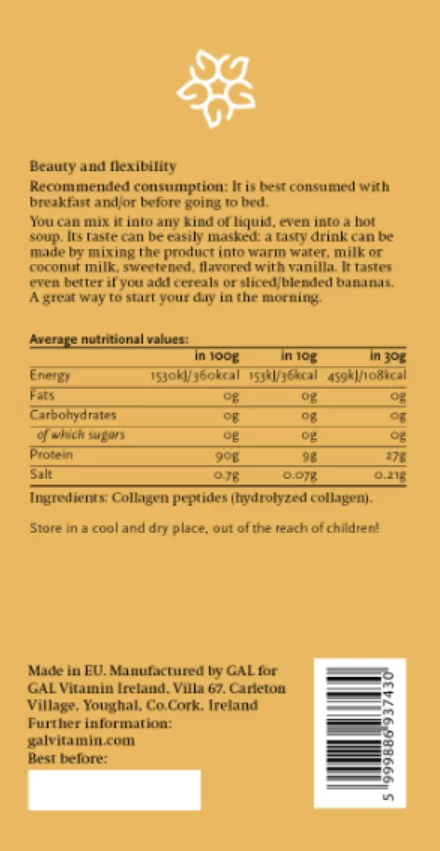
Warnings
KEEP OUT OF REACH OF CHILDREN. DO NOT EXCEED RECOMMENDED DOSE.
If you are undergoing treatment for a medical condition or if you are pregnant or lactating, please consult your medical practitioner before introducing supplementary foods to your normal routine. The dietary supplement should not be used as a substitute for a varied and balanced diet or a healthy lifestyle. Store tightly closed in a cool and dry place.
Studies:
1. Sylvie Ricard-Blum: The Collagen Family. Cold Spring Harb Perspect Biol. 2011 Jan; 3(1): a004978.
2. Szpak, Paul (2011). "Fish bone chemistry and ultrastructure: implications for taphonomy and stable isotope analysis". Journal of Archaeological Science 38 (12): 3358–3372.
3. Fontana et al. (Long-term effects of calorie or protein restriction on serum IGF-1 and IGFBP-3 concentration in humans. Ageing Cell. 2008 Oct; 7(5): 681–687.
4. Bodo Melnik: Dietary intervention in acne - Attenuation of increased mTORC1 signalling promoted by Western diet. Dermatoendocrinol. 2012 Jan 1; 4(1): 20–32.
5. Trepanowski et al.: Impact of caloric and dietary restriction regimens on markers of health and longevity in humans and animals: a summary of available findings. Nutrition Journal 2011, 10:107
6. C.Y. Ewald et al., “Dauer-independent inuln/IGF-1-signalling implicates collagen remodelling in longevity,” Nature, doi:10.1038/nature14021, 2014.
7. Proksch et al.: Oral intake of specific bioactive collagen peptides reduces skin wrinkles and increases dermal matrix synthesis. Skin Pharmacol Physiol. 2014;27(3):113-9.
8. Schwartz et al.: Ingestion of BioCell Collagen(®), a novel hydrolyzed chicken sternal cartilage extract; enhanced blood microcirculation and reduced facial ageing signs. Clin Interv Aging. (2012)
9. Kantor, I et al. 2002. Results of a Study Evaluating the Use of a Dietary Supplement Formula in the Management of Age-Related Skin Changes in Women with Moderate to Severe Wrinkling of the Periorbital Area. Journal of the American 10. Nutraceutical Association. Vol 5, No.2
11. DERMSCAN study, 2008, Lyon France. Cutaneous properties of hydrolyzed collagen
12. Ito et al.: Sebum secretion-blocking composition, and food or beverage containing same. US 8,969,523 B2 (2015 március 3.)
13. MorgantiP.,RandazzoS.D.,BrunoC,(1982)"effectofgelatincysteineonhairafterathreemonthstreatment“, J.Soc.Cosmet.Chemists33,95.
14. RandazzoS.D.,MorgantiP.,(1982)titled:"Theinfluenceofgelatincysteinesupplementationontheaminoacidscompositionofhumanhair",acceptedforpresentationonXVIintern.CongressofDermatology May23-28Tokyo.
15. Morganti P., Bruno C. Colelli G (1983) Geltina-cistina. Cheratogenesies trutturapilifcra Boil, Soc, It. Biol.Sper 59:20.
16. M.P. DE Padova, A. TOSTI, titled: “Gelatin -Cyctine in Seborrheic Alopecia”, department of dermatology university of Bologna –Italy, February 15, 1985. J Appl. Cosmetol 1968;4;55-60 (April/June 1986).
17. Morganti P., G. Fabrizl. B James, C. Bruno, titled: “Effect of gelatin-cystine and serenoa repens extract on free radicals level and hair growth”, Presented at Singapore clinical dermatology 2000 –Singapore 18-20 June, 1998
18. Pam Z., Wikonkal N., Pam N., -15th Annual Meeting of the European Hair Research Society (EHRS) , Jerusalem, Israel, July 6-9, 2011.
19. Benito-Ruiz et al.: A randomized controlled trial on the efficacy and safety of a food ingredient, collagen hydrolysate, for improving joint comfort. International Journal of Food Sciences and Nutrition, 2009, Vol. 60, No. s2 : Pages 99-113
20. Schauss et al.: Effect of the novel low molecular weight hydrolyzed chicken sternal cartilage extract, BioCell Collagen, on improving osteoarthritis-related symptoms: a randomized, double-blind, placebo-controlled trial. J Agric Food 21. Chem. 2012 Apr 25;60(16):4096-101.
22. Jing et al. 2014.
23. Bannai M, Kawai N. New therapeutic strategy for amino acid medicine: glycine improves the quality of sleep. J Pharmacol Sci. 2012;118(2):145-8.
24. File et al.: Beneficial effects of glycine (bioglycin) on memory and attention in young and middle-aged adults. J Clin Psychopharmacol. 1999 Dec;19(6):506-12.
25. Kakoi C. et al.: Collagen peptides enhance hippocampal neurogenesis and reduce anxiety-related behaviour in mice. Biomed Res. (2012)
26. Rubio et al.: Oral ingestion of a hydrolyzed gelatin meal in subjects with normal weight and in obese patients: Postprandial effect on circulating gut peptides, glucose and inuln. Eat Weight Disord. 2008 Mar;13(1):48-53.
27. THE SPECIFIC DYNAMIC ACTION OF GELATIN HYDROLYSATES by DAVID RAPPORT, From the Department of Physiology, Western Reserve University Medical School, Cleveland. Received for publication, October 8, 1926. Published the American Society 28. of Biological Chemists, Inc., Vol 71. p. 75-86 in English.

-Allergen-free
- Glutenfree
- Egg-free
- Soy allergen-free
- Dairy and lactose-free
- Free of sulfur dioxide
- Sugar-free
- GMO-free
- Vegetarian
- Vegan
- Packaging from carbon-neutral production
- 100% recyclable packaging
Green: The product has the described property
Red: The product does not have the described property

